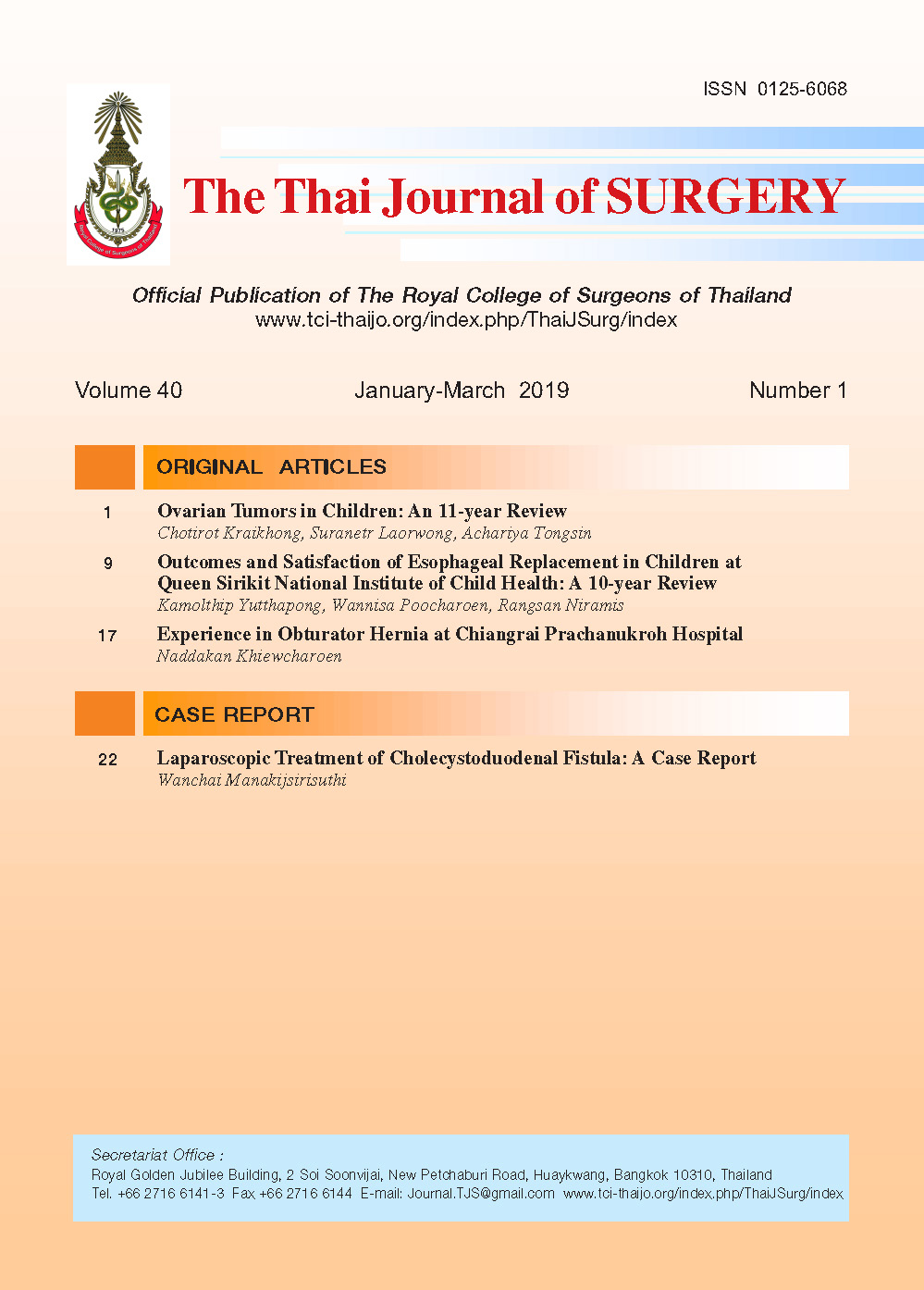Outcomes and Satisfaction of Esophageal Replacement in Children at Queen Sirikit National Institute of Child Health: A 10-year Review
Keywords:
Esophageal replacement, Gastric transposition, Reverse gastric tube esophagoplasty, Outcome, SatisfactionAbstract
Objectives: Esophageal replacement (ER) is a major operation and not frequently preformed especially in children. The aim of this study is to review the outcomes of patients who underwent ER in a 10-year period and evaluate satisfactions of patients or parents after the procedures.
Materials and Methods: Retrospective chart review of all patients who underwent ER at Queen Sirikit National Institute of Child Health during 2007-2016 was conducted. Demographics, causes of ER, types of ER, postoperative outcomes and satisfaction results were collected.
Results: A total of 22 patients underwent ER during the study period. The most common indication for ER was isolated esophageal atresia 13 cases (59.1%) followed by caustic esophageal stricture in 6 case (27.2%). Mean age at the operation was 28 months. Gastric transposition (GT) was the most common procedure performed in 15 cases, followed by colonic interposition (CI), and Reverse gastric tube esophagoplasty (RGT). Over half of cases (59.1%) underwent ER via posterior mediastinal route especially in GT and RGT. Common immediate postoperative complications were pneumonia, wound infection and anastomotic leakage. Mean postoperative initial feeding was 11 days (range 10-14 days). Mean hospital stay was 42 days (range 12-105 days). There was no mortality in all of the patients. For the long-time follow-up, 90% of the patients had appropriate development of age with ability to eat normally and satisfactory quality of life.
Conclusion: The outcomes of ER in children at Queen Sirikit National Institute of Child Health institute is excellent. There are minimal post-operative complications without no mortality. There were no statistic difference of postoperative complications and patient’s development amongst various ER procedures. Long-term post-operative course is satisfactory.
References
2. Kunisaki SM, Coran AG. Esophageal replacement. Semin Pediatr Surg 2017; 26: 105-15.
3. Ludman L, Spitz L. Quality of life after gastric transposition for oesophageal atresia. J Pediatr Surg 2003; 38 (1): 53-7.
4. Ashworth A. Nutrition, Food, Security, and Health. In:Kliegman RM, ed. Pediatrics 20th ed. Philadelphia: Elsevier Inc; 2016: 295-306.
5. Spitz L. Esophageal replacement: overcoming the need. J Pediatr Surg 2014;49(6):849-52.
6. Spitz L. Gastric transposition in children. Semin Pediatr Surg 2009; 18 (1): 30-3.
7. Tannuri U, Maksound-Filho JG, Tannuri AC, Andrade W, Maksound JG. Which is better for esophageal substitution in children, esophagocoloplasty or gastric transposition? A 27-year experience of a single center. J Pediatr Surg 2007; 42(3): 500-4.
8. Burgos L, Barrena S, Andrés AM, Martínez L, Hernández F, Olivares P, et al. Colonic interposition for esophageal replacement in children remains a good choice: 33-year median follow-up of 65 patients. J Pediatr Surg 2010; 45: 341-5.
9. Coopman S, Michaud L, Halna-Tamine M, Bonnevalle M, Bourgois B, Turck D et al. Long-term outcome of colon interposition after esophagectomy in children. J Pediatr Gastroenterol Nutr 2008; 47 (4): 458-62.
10. Lima M, Destro F, Cantone N, Maffi M, Ruggeri G, Domini R. Long-term follow-up after esophageal replacement in children: 45-Year single-center experience. J Pediatr Surg 2015; 50: 1457-61.
11. Koivusalo AI, Sistonen SJ, Lindahl HG, Rintala RJ, Pakarinen MP. Long-term outcomes of oesophageal atresia without or with proximal tracheoesophageal fistula – Gross types A and B. J Pediatr Surg 2017; 52: 1571-5.
12. Koivusalo A, Pakarinen MP, Turunen P, Saarikoski H, Lindahl H, Rintala RJ. Health-related quality of life in adult patients with esophageal atresia--a questionnaire study. J Pediatr Surg 2005; 40 (2): 307-12.
13. Deurloo JA, Ekkelkamp S, Hartman EE, Sprangers MA, Aronson DC. Quality of life in adult survivors of correction of esophageal atresia. Arch Surg 2005; 140 (10): 976-80.
Downloads
Published
How to Cite
Issue
Section
License
Articles must be contributed solely to The Thai Journal of Surgery and when published become the property of the Royal College of Surgeons of Thailand. The Royal College of Surgeons of Thailand reserves copyright on all published materials and such materials may not be reproduced in any form without the written permission.



